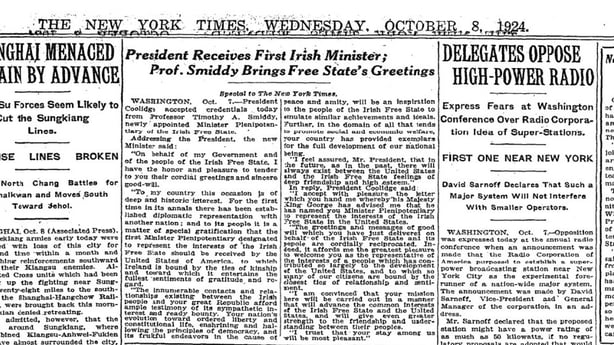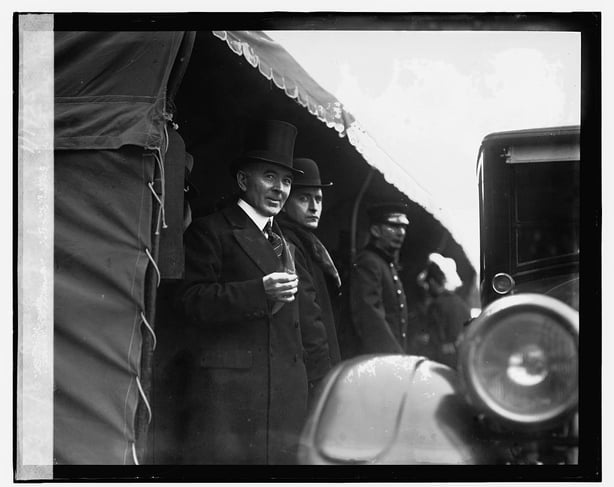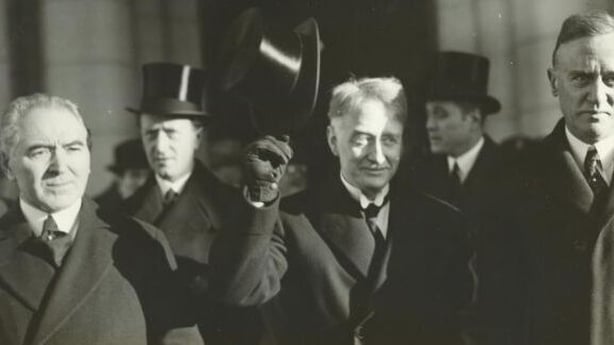Analysis: The Irish Free State made history when Timothy Smiddy was appointed as the nation's first US ambassador in October 1924
A hundred years ago this week, Prof Timothy A. Smiddy presented his credentials to US president Calvin Coolidge. In doing so, Smiddy became the first minister plenipotentiary to be appointed not only by the Irish Free State, but the first representative appointed by any member of the British Commonwealth.
To reach this point, the Free State skilfully exploited any Commonwealth agreements that would benefit their independent relations with the US. The Free State had made Commonwealth history with Smiddy's appointment and simultaneously strengthened the state’s position both domestically and internationally. But considering the popular support among the American public for Irish Independence, it may be surprising that it took nearly three years for relations between the two states to be put on a formal footing.
After the signing of the Anglo-Irish Treaty in December 1921 and the official establishment of the Irish Free State a year later, many expected normal diplomatic relations to begin. However, the outbreak of civil war in Ireland posed a serious threat to the stability of the Provisional Government, and greatly restricted its ability to pursue its foreign policy. Further complicating the situation was a lack of clarity surrounding the legal/diplomatic status of the dominions in the British Commonwealth. The Free State would have to navigate both issues before it could achieve its immediate foreign policy goal: to win international support for the Irish Free State.

Smiddy was first appointed as the Free State’s minister in the US in March 1922, but had to combat both official disinterest and untrustworthiness among his own staff. He was forced to get a wire from Michael Collins affirming his authority over the Irish offices in both New York and Washington DC. He found the offices staffed by people opposed to the Treaty and, consequently, felt it necessary to handwrite his letters back to the Provisional Government until he could employ a trustworthy typist.
The anti-Treaty faction appointed Laurence Ginnell as their representative in the US and he attempted to seize control of the New York office. Luckily for Smiddy, the local police intervened on his behalf, regarding the office as the property of the Provisional Government. Despite this, Smiddy had to continue to operate under an ill-defined and ill-understood status, a position he later described as undignified.
The US waited until October 1922 before requesting its officials in the State Department to clarify the Free State’s status. They noted the Free State had the status of dominion equal to that of Canada, but remarked that any Irish matters should be dealt with through the British embassy until told otherwise. American officials were weary of upsetting Anglo-American relations and fearful of a republican victory in the civil war.

In February 1923, the British government informed the State Department and British Ambassador in the US that Smiddy was an agent of the Free State government. This was done at the request of the Irish government, though it had to pass through the Governor-General (the King’s representative in the Free State). Whatever benefit Smiddy might have gained from this minor clarification of his position was immediately undone when the British embassy made clear to American officials that Smiddy had no diplomatic role.
Undeterred, Smiddy continued to assess the attitudes of the US government to his presence and status, finding that, if it had British backing, they would place no barrier to officially recognising Smiddy as the representative of the Free State. Any momentum gained by Smiddy, however, evaporated after the unexpected death of US president Warren G. Harding in August 1923 which forced Smiddy to carry his frustration into another year.
In February 1924, Smiddy once again protested to the Free State government at the lack of official relations. He informed his minister that he could only get a US department to act on his instructions if that department received instructions from the State Department, who in turn would only do so with a request from the British embassy. Smiddy was dependent on the British embassy and called any action on their part or by the State Department as an 'act of grace’. Smiddy warned that if he ever needed to ask the British embassy for assistance formally, it could be used by opponents of the Free State as evidence that it is still dependent on Britain.

The following month, the Free State once again sought to clarify Smiddy’s position, and asked the British government to enquire whether Smiddy would be accepted by the new president Coolidge. Before responding to the Irish request, the US government first sought the opinion of the British government on dominion representation. The British government felt compelled to allow the appointment of an Irish representative in light of news from Canda, another dominion, that they were also considering appointing a representative.
The Free State also exploited an agreement between Canada and the UK allowing the latter to appoint a minister plenipotentiary to the US, with the liking of the Free State to Canada in the Treaty making it all the more difficult to argue against. The agreed terms specified that the Irish minister would only have authority over matters that solely concerned the Free State.
This was not the last time several dominions successfully pressed for greater rights. At the 1926 Imperial Conference, the Free State, Canada, and South Africa secured the 'Balfour Declaration' which recognised dominions as autonomous communities, equal to each other and the UK. This opened the door for further wins over the following years.
Follow RTÉ Brainstorm on WhatsApp and Instagram for more stories and updates
The views expressed here are those of the author and do not represent or reflect the views of RTÉ





